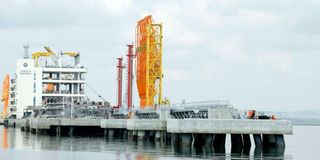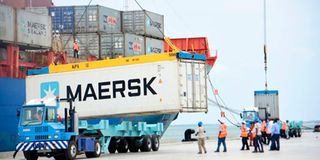Kibaki legacy projects stand tall in Coast region

The new Kipevu Oil Terminal.
Former President Mwai Kibaki's legacy in the Coast region is evident in the many infrastructural developments he oversaw since taking over power in 2003.
In 2012, Kibaki commissioned a number of mega infrastructure projects in Lamu, whose implementation was inherited by President Uhuru Kenyatta’s Jubilee administration.
The Kibaki administration was behind the Sh40 billion first phase of Lamu Port, which was completed in December last year, the Lamu Port South Sudan Sudan – Ethiopia Transport (Lapsset) corridor projects and a number of blue economy developments.
With three out of 23 berths nearing completion in Lamu, Kenya is poised for a bigger share of Africa’s blue economy.
The second Kenyan commercial port was launched in May last year by President Kenyatta and has already handled 11 vessels with a throughput of 1,821 Twenty Foot Equivalent Units (Teus).
At the Mombasa port, Kibaki’s economic footprints include the completion of a Sh32 billion second container terminal, which was financed by the Japan International Cooperation Agency and built by Japanese Toyo Construction Company.
The new terminal is expected to increase Mombasa’s container handling capacity to 1.732 million Teus, up from the current 1.42 million.
The terminal, which will start operations in the coming weeks, is expected to accommodate an additional 450 twenty-foot containers, translating into increased capacity to tap into the lucrative transit business.
It is part of the Mombasa Port Development Programme, which is designed to ensure accommodation of larger vessels, giving Mombasa a competitive edge over the Dar es Salaam and Djibouti ports.
The Mombasa Port is the entryway for landlocked countries including Uganda, South Sudan, Rwanda, Burundi and the Democratic Republic of Congo.

Lamu Port begins operations after receiving its first Cargo Ship at Berth Number 1 during the official launch by President Uhuru Kenyatta in Lamu County on May 20, 2021.
“It will have three berths with lengths of 230, 320 and 350 metres. The larger berths will handle panamax container ships of 20,000 deadweight tonnage and post-panamax vessels of 60,000,” said acting managing director John Mwangemi.
Another outstanding project that was initiated at the port during Kibaki’s tenure is the Sh42 billion Kipevu Oil Terminal 2, which was completed last month.
A dry run is being conducted on the new terminal, which can handle up to four vessels, compared to the existing one, which can only handle one vessel at a time.
The second terminal is expected to cut the cost of petroleum products by lowering demurrage costs, which greatly increase the cost of such commodities.
The new facility will have both subsea and land-based pipelines connecting it to the storage facilities in Kipevu, and the capacity to handle five different fuel products. These include crude oil, heavy fuel oil and three types of white oil products (DPK-aviation fuel, AGO-Diesel and PMS-Petrol).
The facility, which is constructed directly opposite the second container terminal at the port of Mombasa, has the capacity to handle vessels with a Dead Weight Tonnage (DWT) of 200,000 and a dedicated liquefied petroleum gas (LPG) line.
The new terminal will have two LPG offloading lines where, according to the Kenyan government’s plan, Kenya Pipeline Company will be given rights for one line and private companies a second line.
The second line will play a key role in ending the long-time monopoly of gas supply as it will allow new entrants into the business.
As the projects take shape, the Lamu community has been pleading with the national government to honour the late retired President Kibaki’s pledge to have Lamu youth trained on port affairs.
During a visit to Lamu in 2012, then President Kibaki laid the foundation stone for the Lamu Port and pledged that the government would sponsor 1,000 students from Lamu to take port-related courses to enable them to secure jobs at the port.
The students were to be recruited in five groups of 200 students under a programme dubbed Lapsset Presidential Scholarship Programme.
Even after the port was operationalised by President Kenyatta on May 20, 2021, the pledge by Kibaki seems to have been forgotten, since only 400 youths were successfully recruited a few years ago.
The Lamu council of elders and other leaders have called for the recruitment of the remaining 600 youths in honour of the late former President Kibaki.
Lamu council of elders’ deputy chairperson Mohamed Mbwana explained that the Lamu community was not in any way blaming the late Kibaki but rather his successors for failure to fulfill the pledge to have 1,000 local youths sponsored for training on port-related matters.
Mr Mbwana thanked the late Kibaki for fighting for the Lamu people and called on the government and the Lamu Port Corridor Development Authority to ensure Kibaki’s pledge is fulfilled.






